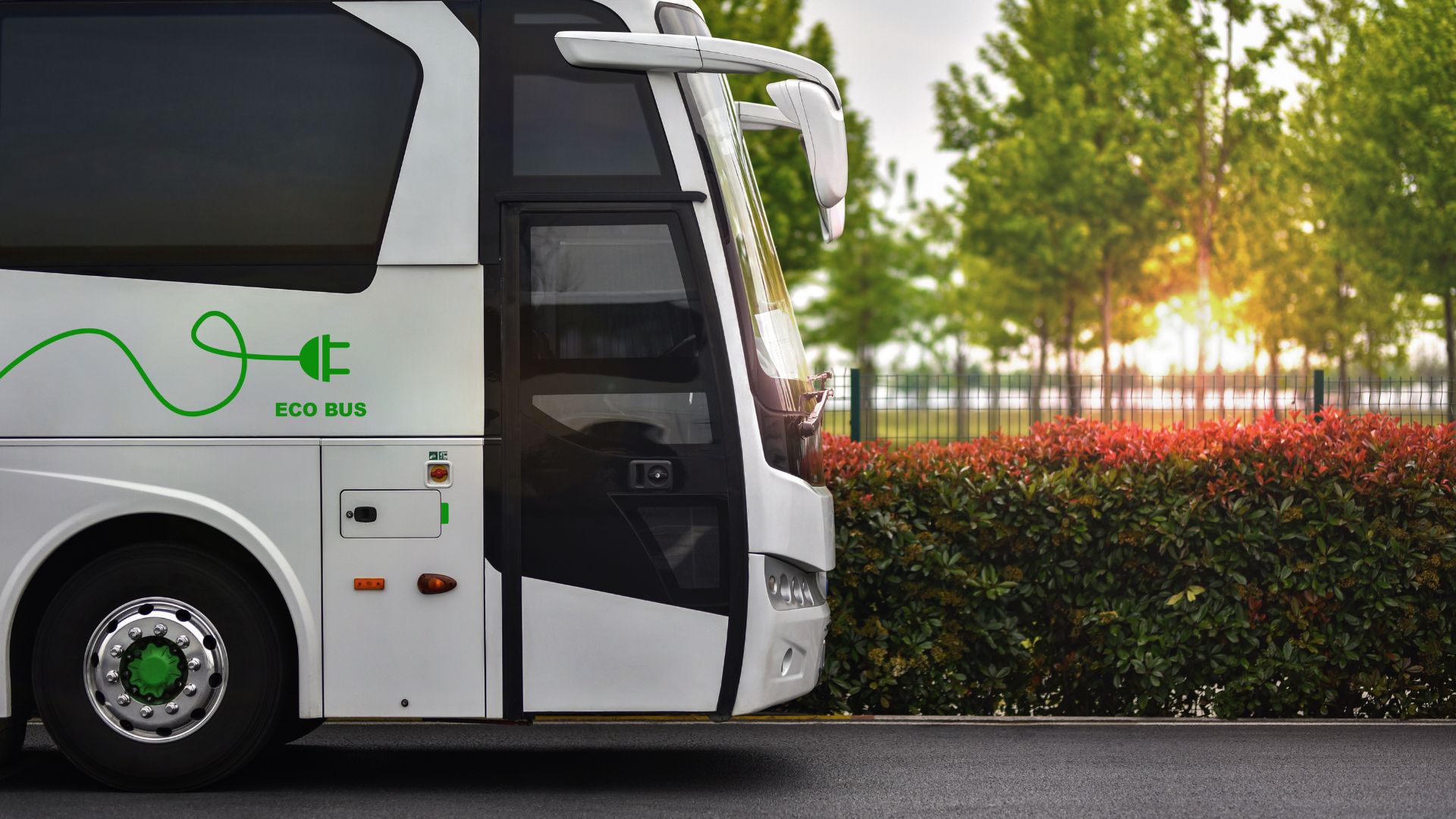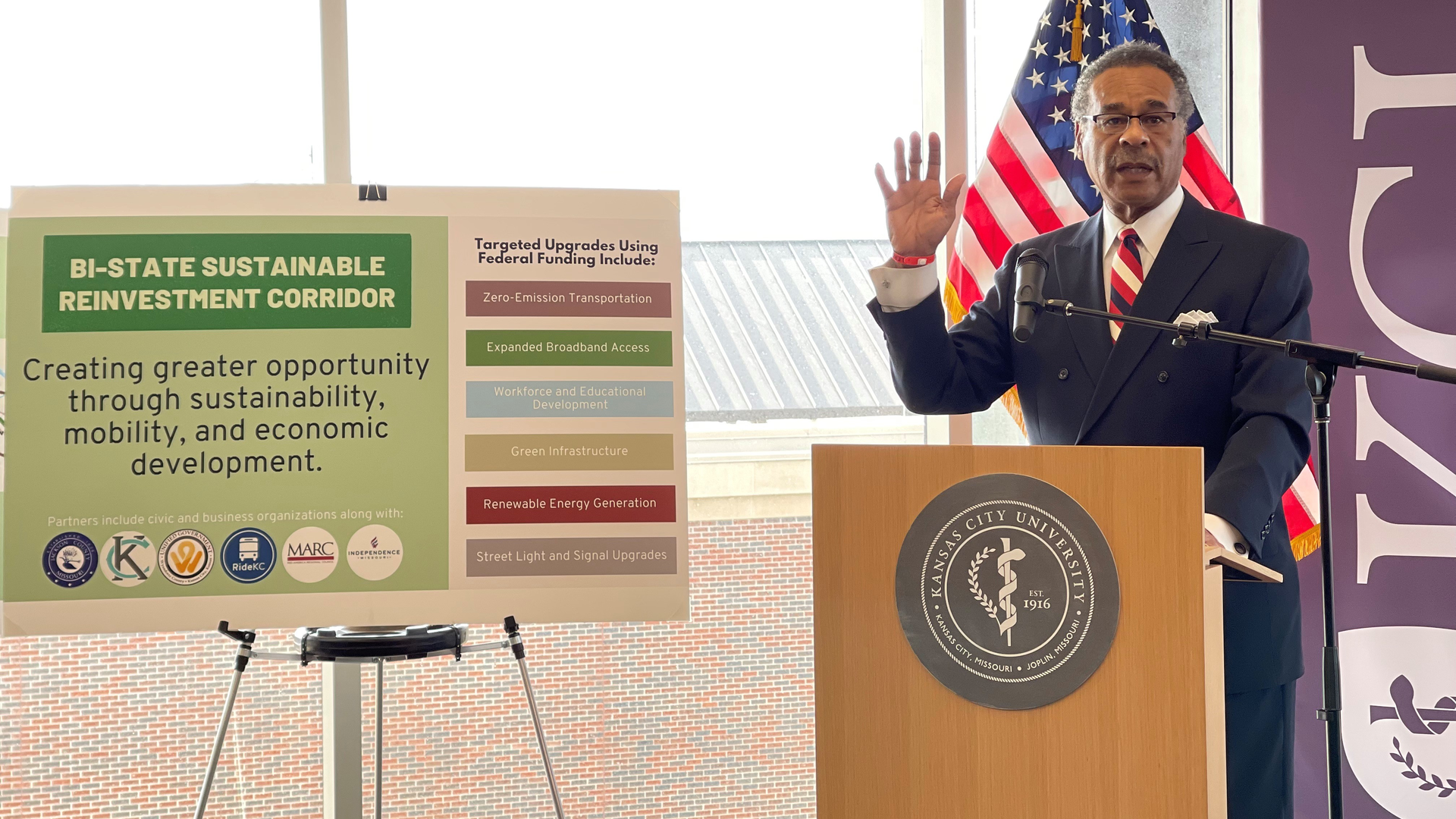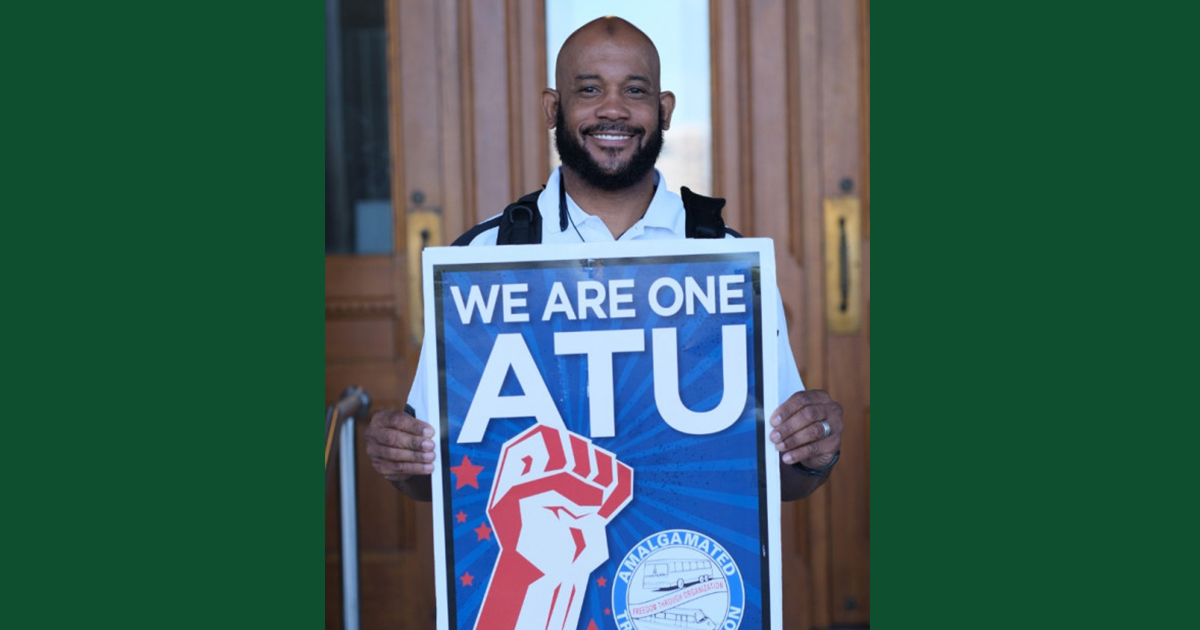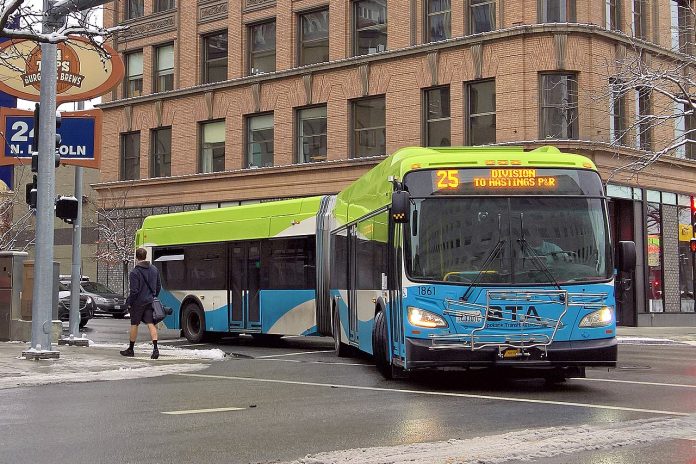
Photo Credit: Oleksandr, Adobe Stock
More than a quarter of greenhouse gases [GHGs) emitted in the US come from transportation – more than from electricity or any other source.[1] Pollution from vehicles causes a significant excess in disease and death in poor communities. Lack of transportation helps keep people in poor communities poor.
Proposals for a Green New Deal include many ways to reduce the climate, health, and inequality effects of a GHG-intensive transportation system. “Transit Oriented Development” (TOD), “smart growth,” and other forms of metropolitan planning reduce climate-and-health threatening emissions while providing more equal access to transportation. Switching from private vehicles to public transit reduces GHG emissions by more than half and substantially reduces the pollution that causes asthma and other devastating health effects in poor communities. Changing from fossil fuel to electric vehicles also greatly reduces emissions. Expanded public transit fights poverty and inequality by providing improved access to good jobs. And expansion of transit itself almost always creates a substantial number of good, often union jobs. Every $1 billion invested in public transit creates more than 50,000 jobs.[2]
Plans for a Green New Deal generally include substantial federal resources to help transform our transportation system.[3] The 2021 “bipartisan” Infrastructure Investment and Jobs Act provided $20 billion over the next five years for transit projects. But meanwhile, efforts at the community, local, and state level have already started creating jobs reducing transportation pollution – models of what we have called a Green New Deal from Below.[4]
These Green New Deal from Below programs are often characterized by multiple objectives – for example, protecting the global climate, improving local health, providing jobs, and countering inequality. And they often pursue concrete ways to realize multiple goals, such as “transit-oriented development” that builds housing near transit to simultaneously shift travel from cars to public transit and to expand access to jobs and urban amenities for people in low-income communities.
Tore Up a Parking Lot – Put Up Affordable Housing
Big Yellow Taxi by Joni Mitchell Author: Joni Mitchell | Watch the video »
In 1970, Joni Mitchell wrote a song with the oft-quoted line, “Paved paradise to put up a parking lot.”[5] In 2022, Chicago tore up a parking lot 400 feet from a transit station and put up an affordable housing complex. That transformation could serve as an emblem of the Green New Deal from Below.
The $40 million, seven-story “transit-oriented development” project, built by a non-profit developer, will help low-income and working-class residents stay in the gentrifying Logan Square neighborhood. The units are all affordable, with half available for Section 8 voucher holders. “This is exciting news for our community,” local Alderman Carlos Ramirez-Rosa wrote. “35th Ward, Logan Square, and Northwest Side neighbors marched, organized, and won this needed affordable housing to address displacement of working class families from our neighborhoods.”
A “NIMBY” group, Logan Square Neighbors for Responsible Development, whose members and supporters included landlords, real estate agents, architects, and an anti-union libertarian lawyer, opposed the project and filed a nuisance lawsuit to block it. Cook County Circuit judge Neil H. Cohen dismissed the suit, declaring,
The provision of affordable housing for low and moderate income residents of the city is a legitimate government interest. Increasing access to public transportation and encouraging public transportation use for people of all incomes is also a legitimate governmental interest. Building 100 affordable housing units near the CTA’s Logan Square Blue Line station is rationally related to these legitimate governmental interests.[6]
A local publication titled its story on the project, “Goodbye, Parking Lot, Hello Affordable Housing.”
Chicago is not alone. In Atlanta, for example, the Metropolitan Atlanta Rapid Transit Authority (MARTA) is sponsoring the Atlanta Affordable Housing and Transit-Oriented Development initiative promoting mixed-income TOD projects located near MARTA’s 38 heavy-rail stations, 12 Atlanta Streetcar light-rail stops, and new transit investment corridors. The first project, a 250-unit affordable housing community called Skyline Apartments, recently held its groundbreaking. Skyline is across the street from the terminus of MARTA’s Summerhill Bus Rapid Transit (BRT) project which will connect the Southeast BeltLine to heavy-rail stations and bus routes in South Downtown Atlanta. Yarojin Robinson, managing director in the Urban Investment Group within Goldman Sachs Asset Management, which is making a significant investment in the project, says, “By investing in affordable housing near MARTA’s transit offerings, the initiative will help to ensure that Atlanta remains accessible for all residents, regardless of household income. We are committed to partnering with Black-owned and Black-led developers and investing in majority-minority communities.”[7]
Transitioning to Transit

U.S. Rep. Emanuel Cleaver speaks at an event introducing the Bi-State Sustainable Reinvestment Corridor – a two state, 24-mile regional rapid transit corridor. Photo Credit: Mass Transit
To reduce GHG pollution it is not sufficient to use more energy efficient vehicles; it is necessary to reduce the number of miles that vehicles travel. For example, between 1990-2017 overall US vehicle fuel efficiency increased 18 percent, largely due to the implementation of CAFÉ standards. But in the same period there was a 50% increase in driving. The result was that, despite higher fuel efficiency, the amount of vehicle emissions increased 22 percent.[8]
Shifting from private vehicles to public transportation is one of the most cost-effective ways to reduce GHG emissions. Yet public transit has been starved for resources for both infrastructure and operations. The 2021 Infrastructure Investment and Jobs Act includes significant funding for public transit. But initiative for actually developing public transit lies at the local and state level – and people at the local and state level are taking advantage of that to launch their own Green-New-Deal-style transit programs.
A group of elected leaders in Kansas and Missouri are seeking funding under the Infrastructure Investment and Jobs Act for a 24-mile regional rapid transit corridor to “enhance mobility, transform communities and reduce carbon emissions.” The proposal will connect Kansas City KS, Kansas City, MO, and Independence, MO with rapid transit integrated with a wide array of related community development projects. It includes:
- Zero-emission transportation options: Electric buses; new and upgraded mobility hubs; expanded KC Streetcar and MAX services; and pedestrian and bicycle infrastructure.
- Affordable housing: Energy-efficient retrofits; new units and construction; and transit-oriented/connected development.
- Green infrastructure: Enhanced tree canopy coverage; upgraded stormwater systems; electric vehicle charging stations; and residential solar panels.
- Broadband Access: Implementation of wired and wireless service; increased capacity; and updated equipment.
- Safety and security enhancement: Shot spotter;[9] license plate readers; Community Improvement Districts; and other public safety technologies.
- Economic development: Workforce training; access to childcare; and private investment along the corridor.
- Public schools and libraries: Renewable energy and energy efficiency projects to reduce utility costs.[10]
In April, 2022 the Kansas City MO Area Transportation Authority received more than $27 million from the Infrastructure Investment and Jobs Act for local transit in the Kansas City region. Announcing the funding, Representative Emanuel Cleaver, II of Missouri said,
I see brand new electric buses, upgraded transit facilities, and, of course, good-paying jobs for workers who will be responsible for building, maintaining, and operating the future of transit in Kansas City. That’s going to lead to lower emissions, cleaner air, and stronger communities that will continue to grow in an equitable fashion.
He added that it will be “a foundational component of the Bi-State Sustainable Reinvestment Corridor.”[11]
While public transit is often associated with urban areas, it can also be designed for rural ones. Eleven rural counties near Harrisburg, PA have started testing a “Stop Hopper” microtransit service to allow residents to schedule rides on smaller, neighborhood-friendly-sized public transit vehicles. Riders can travel anywhere within the designated zone on a nine-person ADA accessible van for $2; seniors ride free. The program is designed to support small-town economies by connecting local residents with job opportunities and access to food, pharmacy, and other necessities.[12]
Of course, microtransit can sometimes be used to privatize, de-unionize, and even dismantle existing transit systems. For example, in Denton County, TX microtransit company Via set out to replace all fixed-route bus service (and unionized drivers) with on-demand vehicles driven by independent contractors who are hailed by an app. Denton bus operator and Amalgamated Transit Union member Jim Owen, who had been attending bus company board meetings for eight years, warned his co-workers that the intent was to eliminate all union jobs.
The drivers teamed up with a cross-union group called Denton Worker, formed in 2019 to connect local unionists so they could assist each other in their fights. Its goal, according to UPS part-timer Will Hale, a steward with Teamsters Local 767, was to “find workers who needed to be organized, find issues around unfair labor practices and wage theft, and try to be a touchstone for workers in Denton.” The bus drivers and Denton Worker organized a group they called “No Bus Cuts Denton.” They began riding the buses to talk to people and discovered the cuts would affect “people who are really fighting for the basics of life, who don’t have access to smartphones or banking services.” After mass attendance and “call-in filibusters” at transit agency board meetings, No Bus Cuts Denton forced the company to preserve five of the eight fixed-route bus lines. Bus operator Paula Jean Richardson concludes, “We won a battle, but we still have a war going on. We have to keep fighting.”[13]
Electrifying transit

Mustafa Salahuddin is the president and business agent of the Amalgamated Transit Union Local 1316 in Bridgeport, Connecticut. In this edited interview with Labor Network for Sustainability, he tells how the local became part of the company procurement process—leading the company to convert to climate-safe electric buses. Credits Taylor Mayes, Connecticut Roundtable on Climate and Jobs.
Mustafa Salahuddin is the president and business agent of the Amalgamated Transit Union Local 1316 in Bridgeport, Connecticut. In 2014 the local began a campaign for improvements in drivers’ workstations, including relocating monitors, installing adjustable seatbelts, and correcting blind spots. The company corrected the blind spots and made other union-demanded changes. Then Salahuddin proposed that the union become part of the company’s procurement process. When the COO agreed, Salahuddin, and active member of the Connecticut Roundtable on Climate and Jobs as well as a union official, began advocating for low- and no-carbon buses. Salahuddin recalls that he told the company official,
We’re both young. You should want to leave a legacy that you had something to do with renewable energy. You’re a young man. It is something to be proud of later on. Your kids can look back on it and say, my dad had something to do with that. I told him climate change, fossil fuels — it’s a no-brainer. That diesel with that air that’s going through the bus – the drivers and passengers are breathing unhealthy and detrimental air. Sit with the drivers and you’ll see. This will stop people from getting sick so much. He said, you’re absolutely right. So he purchased about four or five hybrids. Then they ordered five to seven fully electric ones. Now he wants to go fully electric. His goal is to try to do it before the projected year of 2030. I’m looking to the unveiling of our first fully electric buses. I’m really looking forward to that.[14]
Twenty-five million children ride diesel school buses every school day.[15] In many locations school buses are becoming a first target for electrification. Groups concerned with young people’s health, community air pollution, and GHG climate destruction have been campaigning to replace diesel school buses with electric ones. In 2017, for example, Chispa (Spanish for ‘Spark’), an offshoot of the League of Conservation Voters aiming to create healthier environments in Latinx communities and communities of people of color, launched the “Clean Buses For Healthy Niños” campaign to influence governors, school boards, and local leaders to fund replacement of diesel school buses. State governments have begun allocating funds for electric school buses in Illinois, Massachusetts, Ohio, Michigan, California, Maryland, New Jersey, Washington, Arizona, Nevada, and New York.[16] Maryland’s Montgomery County Public Schools will replace all its diesel vehicles with electric ones, starting with 326 electric buses over the next four years, the single largest purchase of electric school buses in North America.[17]
Electrification of school buses took a quantum leap forward this April, when the New York State legislature and Gov. Kathy Hochul passed a state budget with a plan to make the state’s 50,000 school buses 100% electric by 2035. New York is the first state to commit to fully electrifying its school bus fleet. Electrifying school buses in New York City alone would reduce emissions as much as taking 650,000 passenger vehicles off the road.[18]
Free Transit, Free Bikes for Kids
Anna Zivarts on hiring people who can’t drive to improve access. Author: Eno Center for Transportation | Watch the video »
This March the Washington state legislature approved “Move Ahead Washington,” a $17 billion, 16-year transportation package that doubles state support to local transportation agencies. The law makes the biggest investments in sustainable transportation in the state’s history, including $1.45 billion for public transit grants. While past funding packages allocated less than 10% of their budgets to “multimodal transportation” such as transit, bike, and pedestrian projects, “Move Ahead Washington” allocates 18%. Critics point out that the package allocates $4 billion to expanding highway capacity, but most of that is for completing projects already started.
30% of Americans are unable to drive, either due to the costs of car ownership, age, or disability.[19] In 2021, Disability Rights Washington started a Disability Mobility Initiative to mobilize “non-drivers” to have their needs included in forthcoming state transportation legislation. The campaign, according to its director Anna Zivarts, “shifted the funding priorities of this package.” Transit and active transportation will receive funding from the state’s cap-and-invest carbon pricing program.
In order to receive those transit support grants, agencies must adopt a free fare program for riders under 18. Young riders will receive an all-access pass to the full transit network in Washington, including Washington State Ferries and Amtrak Cascades. The free transit for kids is intended to help create a culture of transit riding. The package doubles funding for safe routes to school and bicycle and pedestrian projects. It provides bicycle education programs for students at every level – and every kid who participates in the program will be given a free bike and all of the necessary accessories.[20]
Cleaning Up Big Trucks

Hybrid electric bus in Washington State. Photo credit: Jdubman, Wikimedia Commons
Medium- and heavy-duty trucks are only a small fraction of all vehicles on the road, but they account for more than 60% of tailpipe nitrogen oxide and particulate emissions. California has a special waiver from the EPA that allows it to require that a growing percentage of all medium- and heavy-duty trucks sold be zero-emission. Manufacturers must increase their zero-emission truck sales to 30-50% by 2030 and 40-75% by 2035.
Other states are allowed to follow California’s rules, and five of them — Oregon, Washington, New York, New Jersey and Massachusetts – have adopted this California “Advanced Clean Truck rule.” Several other states are now considering doing so. Oregon has also adopted the “Heavy-Duty Omnibus rule,” which will require new fossil fueled trucks to be 90% cleaner.
In 2020 fifteen governors pledged to make 100% of bus and truck sales electric by 2050.
The result will be a growing number of electric-powered large pickups, buses, garbage trucks and tractor-trailers on the road. Paul Miller, executive director of Northeast States for Coordinated Air Use Management, a nonprofit that supports air quality regulators, says the rules could “significantly reduce or eliminate greenhouse gas emissions as well as conventional air pollutants like nitrogen oxides.” Vehicle makers, he added, “don’t make money on public goods like clean air, so it’s not part of their product development plans unless something is in place to require its inclusion.”
While our federal system makes such state initiatives possible, there are limits to what individual states can do. For example, they can’t ban dirty trucks coming in from other states. But as with other tailpipe standards that started in California and spread to other states, the Advanced Clean Truck rule will put enormous pressure on manufacturers to clean up their trucks. Indeed, according to Bloomberg News, “The U.S. trucking industry is set to be transformed by a handful of states adopting zero-emission vehicle requirements.”[21]
Toward All-Electric Transportation
Gov. Hochul signs legislative package to spur energy efficiency, savings, & reduce greenhouse gasses. Author: Governor Kathy Hochul | Watch the video »
In August 2021, New York State passed a law requiring all passenger vehicles sold in the state to be emission-free by 2035. It also requires all medium- and heavy-duty vehicles to be emission-free by 2045 and requires by 2023 a detailed plan to meet these goals. Governor Kathy Hochul said, “New York is implementing the nation’s most aggressive plan to reduce the greenhouse gas emissions affecting our climate and to reach our ambitious goals, we must reduce emissions from the transportation sector, currently the largest source of the state’s climate pollution.” She added, “The new law and regulation mark a critical milestone in our efforts and will further advance the transition to clean electric vehicles, while helping to reduce emissions in communities that have been overburdened by pollution from cars and trucks for decades.” New York joined pioneer California, which has ordered all new vehicles sold to have zero-emissions by 2035.[22]
New York State established goals for electrifying transportation but left detailed planning for 2023 report. So how do you actually do it? In 2021 Seattle approved a “Transportation Electrification Blueprint” that spells out such details. The plan is designed to lower greenhouse gas emissions and air pollution while increasing electric mobility options and creating a pipeline of clean energy jobs and workforce diversity. It is one means of implementing the city’s 2019 Green New Deal plan, which requires the city to be carbon neutral by 2030.
The plan was developed by Seattle’s Office of Sustainability and Environment, Department of Transportation, Office of Economic Development, and Seattle City Light. Seattle City Light is a municipally-owned power company established as a city department in 1910. In 2005 City Light became the first electric utility in the country to achieve zero net greenhouse gas emissions by divesting ownership in a coal-fired power plant, investing in renewables, increasing energy efficiency programs, and purchasing offsets for its remaining emissions.[23] The Transportation Electrification Blueprint requires:
- 100 percent of shared mobility, such as carshare services, must have zero emissions.
- 90 percent of all personal trips must have zero emissions.
- 30 percent of all goods delivery must have zero emissions.
- 100 percent of the city’s vehicle fleet will be zero-emission.
- One or more “Green & Healthy Streets” areas where streets are closed to cars and goods are delivered by electric vehicles.
- Electric power infrastructure to enable the transition to electric transportation technologies and vehicles.
Seattle City Light is already implementing parts of the Blueprint. Sixteen electric vehicle fast chargers have already been installed with 25 more in the works. Seattle City Light has launched time-of-day rate pilot programs for residential and commercial customers and is working with King County Metro to support the adoption of battery-powered buses and with Washington State Ferries and the Port of Seattle to support electrification.
According to David Logsdon, director of electrification and strategic technology at City Light, the plan “lays out the priorities for City Light’s Transportation Electrification efforts, the equity outcomes we intend to achieve via the portfolio, and what initial milestones we will achieve as we invest in the key sectors of public transit; commercial, government, and nonprofit fleets; and personal mobility.” The plan “builds on the utility’s core mission to achieve a vision of the healthy future that our region depends on—one that is built in concert with our community stakeholders and delivers a grid that is equitable, carbon-neutral, modernized, and future-enabled.”[24]
Bikes and Hikes
JFK Drive in SF Should Remain Car-Free. Author: NBC Bay Area | Watch the video »
Expansion of roads and highways has been viewed as “American as apple pie.” But in April 2022, the San Francisco Board of Supervisors voted 7-4 to permanently close a mile-long section of JFK Drive to vehicles. The street, which had some of the highest injury rates in San Francisco, had been closed early in the COVID pandemic to provide open space for outside activities. When the city considered reopening it to traffic people rallied and marched on the road to keep it vehicle-free. The ordinance keeping the road closed to cars also provided for shuttles for people with mobility issues.[25]
Reducing vehicle traffic is also being accompanied by expansion of more environment-friendly alternatives. In February, 2022 the Berkeley CA city council unanimously approved a plan for Telegraph Avenue, the one-way street through the main business district for the University of California campus, that would change a lane for cars and trucks into a dedicated bus lane, with the remaining lane shared by bikes, cars, and trucks. The plan also promised to study a proposal by the student group Telegraph for People to ban private automobiles altogether on Telegraph Avenue.[26]
In Buffalo, NY federal funding is making possible new projects to expand walking and biking access to the city’s waterfront. The centerpiece will be a “skybridge” that will allow people to walk from a railroad terminal to a popular sports arena. An abandoned railroad right-of-way will also be transformed into a 1.5-mile walkway and bikeway, modeled on New York City’s Highline, which will create a direct connection between the city’s downtown and waterfront and help ensure equitable access to the waterfront. $1 million is set aside for new bicycle and pedestrian improvements.[27]
Alternatives to private autos are now often being referred to as “mobility.” For example, in 2020 the city of Austin passed a “Mobility Bond” which raised $460 million for transportation infrastructure projects. Its Local Mobility Program funds bikeways, sidewalks, safe routes to school, transit enhancement, vision zero,[28] urban trails, and neighborhood partnering programs. Its first construction project, authorized in early 2022, will provide pedestrian crossings, transit stops, asphalt speed cushions, pavement markings and signage to enhance safety, and mobility and transit access in neighborhoods throughout Austin. Austin’s Assistant City Manager Gina Fiandaca commented, “We heard in 2016, 2018 and 2020 that delivering safety and mobility improvements for Austin is on the top of voter’s minds. The community has given us the resources and now it’s our job to make sure the improvements happen so all Austinites can get to their destinations safely and sustainably with more mobility options.”[29]
A crucial aspect of the Green New Deal is its emphasis on participation in planning and decision-making. It eschews the all-too-familiar approach of tearing down a neighborhood to build a highway without input from those being displaced. Expanded forms of community participation in decision-making are similarly essential for Green New Deal from Below transportation programs. In Culver City CA, for example, in 2021 the city council called for a “bold plan to implement bus and bike mobility lanes now.” In response, the city’s transportation department developed a plan to redistribute space on streets for a bus lane and a separate bike lane “to encourage mobility in the city while attempting to alleviate traffic congestion.”
According to the Culver City News, “the project required a great deal of input from the community, so outreach was done in several stages.” Following the launching of its website the project was discussed at meetings of three different commissions before the full website was launched. A Community Project Advisory Committee (CPAC) was created to further solicit input from various public bodies. The CPAC includes Special Interest Groups, City Committees, Business Associations, and Neighborhood Associations. Meetings on the project were also held in the Mobility Subcommittee and the Business Roundtable, and several Community Workshops. The city used both digital and traditional advertising, documenting over 40,000 hits from Nov. to Jan. Almost 25,000 of those views came from social media, including 11,805 from Facebook and 10,837 from Twitter. “The project has been through four different designs, and 11 project guidelines were created with community input and adhered to throughout the process.”[30]
Getting from Here to There

Getting people and material from one place to another is crucial for any society. Our private vehicle-oriented transportation system leads to enormous inequality, waste, environmental destruction, injury, and death. Our fossil fuel-based transportation systems, local, regional, and national, generate climate change, asthma, and other poisonous health effects.
Even in the most capitalistic society, transportation cannot be left to the market; it takes highways, railroad tracks, traffic regulation, and myriad other forms of action by society. It requires systems, not just individual vehicles. That means public planning, investment, and rights-of-way.
National transportation requires national railroads, highways, planning, and investment – in short, national systems. Green New Deal proposals include substantial investment in transforming our transportation system.
But much transportation is not national but local and regional. Transportation infrastructure is always located in specific places. Transportation has enormous effects on the places where it is located. And our federal system puts control of a large part of the transportation system in state and local hands. So there are substantial opportunities for implementing Green New Deal transportation policies “from below.”
As we have seen, this is actually happening in many places. In some cities, states, and rural areas transit systems are being expanded and encroaching on the domination of private vehicle transportation. Cars, trucks, and buses are being electrified to reduce pollution and protect the climate. Pathways for walking and biking are being expanded, and in some cases bicycles and transit are being made available free to expand access and use. Metropolitan planning is locating housing, workplaces, and amenities close to transit. Such programs serve the immediate needs of local users, protect the climate, and lay the groundwork for transforming the transportation system nationally.
Transforming our transportation system is essential to realizing the goals of the Green New Deal. It is already starting to happen – from below.
[1] EPA https://www.epa.gov/ghgemissions/sources-greenhouse-gas-emissions
[2] “Economic Impact of Public Transportation Investment,” American Public Transportation Association, February, 2020. https://www.apta.com/research-technical-resources/research-reports/economic-impact-of-public-transportation-investment/
[3] For a detailed presentation of Green New Deal transportation policy see “A Green New Deal for City and Suburban Transportation,” Data for Progress, March 2020. https://t4america.org/wp-content/uploads/2020/03/20.03_GND-Transit_use_v4.pdf
[4] Jeremy Brecher, “The Green New Deal – From Below,” Labor Network for Sustainability, October 22, 2021. https://www.labor4sustainability.org/strike/the-green-new-deal-from-below/
[5] Joni Mitchell, Big Yellow Taxi. https://www.youtube.com/watch?v=94bdMSCdw20
[6] “Goodbye parking lot, hello affordable housing: Logan TOD construction starts next month,” Streetsblog, August 18, 2020. https://chi.streetsblog.org/2020/08/18/goodbye-parking-lot-hello-affordable-housing-construction-on-logan-tod-starts-next-month/; Jack Crawford, “Affordable Housing Development Emmett Street Apartments Wraps Up In Logan Square,” Chicago YIMBY, November 27, 2021.
For an account of how the project was won, see Carlos Ramirez-Rosa, “How a Socialist City Councilor Won 100% Affordable Housing in a Gentrifying Chicago Neighborhood,” Jacobin, November 5, 2022.
[7] “MARTA, Goldman Sachs announce $100 million increase to Atlanta affordable housing TOD initiative,” Mass Transit, March 23, 2022. https://www.masstransitmag.com/technology/facilities/press-release/21261484/metropolitan-atlanta-rapid-transit-authority-marta-marta-goldman-sachs-announce-100-million-increase-to-atlanta-affordable-housing-tod-initiative
[8] “A Green New Deal for City and Suburban Transportation,” Transit Center, p. 5. https://transitcenter.org/wp-content/uploads/2020/03/20.03_GND-Transit_use_v4.pdf
[9] “Shot spotter” is a gunshot detection system. For a report critical of shot spotter, see “The Chicago Police Department’s Use of Shotspotter Technology,” City of Chicago Office of Inspector General, August 24, 2021. https://igchicago.org/wp-content/uploads/2021/08/Chicago-Police-Departments-Use-of-ShotSpotter-Technology.pdf
[10] Mischa Wanek-Libman, “Kansas-Missouri Bi-State Sustainable Reinvestment Corridor project proposed,” Mass Transit, Feb. 22, 2022. https://www.masstransitmag.com/bus/infrastructure/article/21257692/kansasmissouri-bistate-sustainable-reinvestment-corridor-project-proposed
[11] “Congressman Cleaver announces $27 million from Bipartisan Infrastructure Law for Kansas City Transit,” Northeast News, April 7, 2022. http://northeastnews.net/pages/congressman-cleaver-announces-27-million-from-bipartisan-infrastructure-law-for-kansas-city-transit/
[12] Christopher Benson, “Public transit service expanding in Valley counties,” The Daily Item, March 17, 2022. https://www.dailyitem.com/news/public-transit-service-expanding-in-valley-counties/article_adef15a2-a580-11ec-9fe0-738f5eb41ffd.html
Error! Hyperlink reference not valid.
[13] Joe DeManuelle-Hall, “Texas Union Activists Fight ‘Microtransit’ Privatization,” Labor Notes, March 8, 2022. https://www.labornotes.org/blogs/2022/03/texas-union-activists-fight-microtransit-privatization
[14] “Amalgamated Transit Union Bus Drivers Steer Procurement to Electric Buses,” Making a Living on a Living Planet, November 13, 2019. https://www.labor4sustainability.org/articles/amalgamated-transit-union-bus-drivers-steer-procurement-to-electric-busses/
[15] “Clean Buses for Healthy Ninos,” CHISPA, League of Conservation Voters. https://chispalcv.org/clean-buses-for-healthy-ninos/
[16] Ibid.
[17] Leighton Schneider, “Maryland school district replacing diesel school buses with electric,” ABC News, March 7, 2021. https://abcnews.go.com/Technology/maryland-school-district-replacing-diesel-school-buses-electric/story?id=76286416
[18] Michelle Lewis, “New York State commits to 100% electric school buses by 2035,” Electrek, April 8th 2022. https://electrek.co/2022/04/08/new-york-state-governor-100-electric-school-buses-2035/
[19] “A Green New Deal for City and Suburban Transportation,” p. 7.
[20] Ryan Packer, “Welcome to the Move Ahead Washington Era,” The Urbanist, March 13, 2022. https://www.theurbanist.org/2022/03/13/welcome-to-the-move-ahead-washington-era/
[21] Laura Bliss, “Six States Adopt Clean Truck Rule,” Bloomberg News, January 6, 2022. https://www.ttnews.com/articles/six-states-adopt-clean-truck-rule
[22] Zack Burdryk, “Hochul signs law requiring zero-emission passenger vehicles by 2035,” TheHill, September 8, 2021. https://thehill.com/policy/energy-environment/571385-hochul-signs-law-requiring-zero-emission-passenger-vehicles-by-2035?rl=1&utm_source=InsideClimate+News&utm_campaign=1a21269978-&utm_medium=email&utm_term=0_29c928ffb5-1a21269978-327490529
[23] Seattle City Light. https://www.seattle.gov/city-light/about-us/history
[24] Peter Maloney, “Seattle City Light, agencies release clean transportation electrification plan,” American Public Power Association, March 24, 2021. https://www.publicpower.org/periodical/article/seattle-city-light-agencies-release-clean-transportation-electrification-plan. “Seattle’s Clean Transportation Electrification Blueprint,” City of Seattle, March, 2021. https://www.seattle.gov/documents/Departments/OSE/ClimateDocs/TE/TE%20Blueprint%20-%20March%202021.pdf
[25] “San Francisco Officials Vote to Keep JFK Drive Car-Free,” NBC Bay Area, April 27, 2022. https://www.nbcbayarea.com/news/local/san-francisco/officials-expected-to-vote-on-whether-jfk-drive-in-sf-should-remain-car-free/2874687/
[26] Anna Armstrong, “Berkeley reimagines Telegraph Avenue streetscape as car-free zone,” Daily Californian, February 1, 2022. https://www.dailycal.org/2022/01/26/berkeley-reimagines-telegraph-avenue-streetscape-as-car-free-zone/
[27] Robert J. McCarthy, “New federal money to connect DL&W to KeyBank Center; aid other ‘green’ projects,” Buffalo News, May 1, 2022. https://buffalonews.com/news/local/new-federal-money-to-connect-dl-w-to-keybank-center-aid-other-green-projects/article_5317d9bc-a3ae-11ec-ade2-6b6a2c1178ca.htmlError! Hyperlink reference not valid.
[28] “Vision Zero” is “a strategy to eliminate all traffic fatalities and severe injuries, while increasing safe, healthy, equitable mobility for all.” Vision Zero Network. https://visionzeronetwork.org
[29] “Austin City Council awards first 2020 Mobility Bond construction contract,” Mass Transit, March 25, 2022. https://www.masstransitmag.com/alt-mobility/shared-mobility/article/21261779/austin-city-council-awards-first-2020-mobility-bond-construction-contract
[30] Christian May-Suzuki, “Moving Forward: Culver City accepts mobility lane project,” Culver City News, February 11, 2021. https://www.culvercitynews.org/moving-forward-culver-city-accepts-mobility-lane-project/

